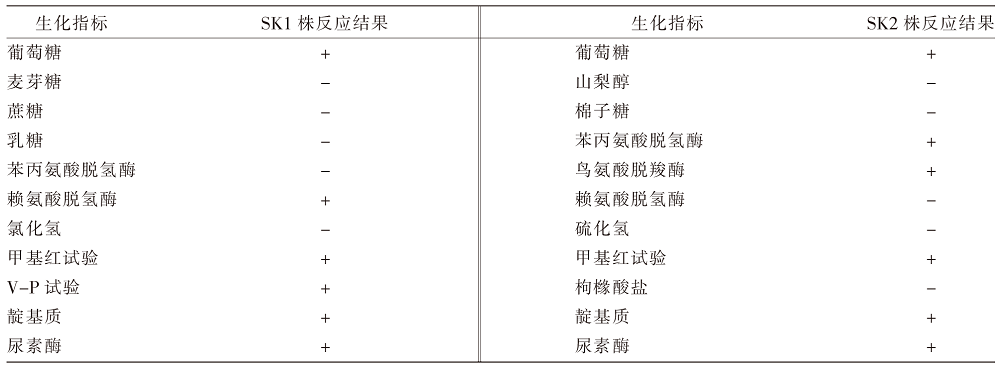| [1] |
刘燕云, 柴家前. 奇异变形杆菌研究进展[J]. 中国兽医学报, 2017, 37(1): 196-200.
|
| [2] |
MARQUES C, BELAS A, ABOIM C, et al. Clonal relatedness of Proteus mirabilis strains causing urinary tract infections in companion animals and humans[J]. Veterinary Microbiology, 2019, 228:77-82.
doi: 10.1016/j.vetmic.2018.10.015
|
| [3] |
俞赵荣, 杨侃侃, 王元红, 等. 1株番鸭源奇异变形杆菌的分离鉴定及其毒力基因分析[J]. 中国动物传染病学报, 2020, 28(3): 14-20.
|
| [4] |
CHEN C Y, CHEN Y H, LU P L, et al. Proteus mirabilis urinary tract infection and bacteremia: Risk factors, clinical presentation, and outcomes[J]. Journal of Microbiology, Immunology and Infection, 2012, 45(3): 228-236.
doi: 10.1016/j.jmii.2011.11.007
|
| [5] |
LIU H, ZHU J M, HU Q W, et al. Morganella morganii, a non-negligent opportunistic pathogen[J]. International Journal of Infectious Diseases, 2016, 50:10-17.
doi: 10.1016/j.ijid.2016.07.006
pmid: 27421818
|
| [6] |
梁彩倩, 孔庆磊, 符永玫, 等. 尿液标本分离的奇异变形杆菌质粒介导喹诺酮类耐药基因的研究[J]. 实用医学杂志, 2017, 33(24): 4152-4155.
|
| [7] |
马丽莎, 章文欣, 廖娟, 等. 鸡源欧文氏菌的分离鉴定及耐药基因检测[J]. 当代畜牧, 2022(11): 26-31.
|
| [8] |
孙坚, 刘雅红, 冯友军. 动物源细菌耐药性研究现状与对策[J]. 生物工程学报, 2018, 34(8): 1246-1258.
|
| [9] |
ZOWAWI H M, SARTOR A L, BALKHY H H, et al. Molecular characterization of carbapenemase-producing Escherichia coli and Klebsiella pneumoniae in the countries of the Gulf Cooperation Council: Dominance of OXA-48 and NDM producers[J]. Antimicrobial Agents and Chemotherapy, 2014, 58(6): 3085-3090.
doi: 10.1128/AAC.02050-13
|
| [10] |
CHENG Z S, THOMAS P W, JU L C, et al. Evolution of New Delhi metallo-β-lactamase (NDM) in the clinic: Effects of NDM mutations on stability, zinc affinity, and mono-zinc activity[J]. Journal of Biological Chemistry, 2018, 293(32): 12606-12618.
doi: 10.1074/jbc.RA118.003835
pmid: 29909397
|
| [11] |
廖娟, 石英子, 冯丹妮, 等. 兔源奇异变形杆菌的分离鉴定及耐药基因检测[J]. 江苏农业科学, 2021, 49(4): 125-129.
|
| [12] |
SUN Y D, WEN S S, ZHAO L L, et al. Association among biofilm formation, virulence gene expression, and antibiotic resistance in Proteus mirabilis isolates from diarrhetic animals in Northeast China[J]. BMC Veterinary Research, 2020, 16(1): 176.
doi: 10.1186/s12917-020-02372-w
|
| [13] |
ADAMUS-BIALEK W, ZAJAC E, PARNIEWSKI P, et al. Comparison of antibiotic resistance patterns in collections of Escherichia coli and Proteus mirabilis uropathogenic strains[J]. Molecular Biology Reports, 2013, 40(4): 3429-3435.
doi: 10.1007/s11033-012-2420-3
|
| [14] |
蒋增海, 邓同炜, 赵攀登, 等. 猪源奇异变形杆菌分离与鉴定及16S rRNA基因序列同源性分析[J]. 贵州农业科学, 2017, 45(12): 91-94.
|
| [15] |
王俊书, 徐进强, 金红岩, 等. 兔奇异变形杆菌的分离鉴定及耐药性分析[J]. 中国畜牧兽医, 2019, 46(5): 1508-1515.
doi: 10.16431/j.cnki.1671-7236.2019.05.030
|
| [16] |
WANG J T, CHEN P C, CHANG S C, et al. Antimicrobial susceptibilities of Proteus mirabilis:A longitudinal nationwide study from the Taiwan surveillance of antimicrobial resistance (TSAR) program[J]. BMC Infectious Diseases, 2014, 14:486.
doi: 10.1186/1471-2334-14-486
|
| [17] |
SHAABAN M, ABD EL-RAHMAN O A, AL-QAIDI B, et al. Antimicrobial and antibiofilm activities of probiotic lactobacilli on antibiotic-resistant Proteus mirabilis[J]. Microorganisms, 2020, 8(6): 960.
doi: 10.3390/microorganisms8060960
|
| [18] |
张萍, 程悦宁, 张海威, 等. 狐狸流产奇异变形杆菌的分离鉴定及特征分析[J]. 中国畜牧兽医, 2019, 46(11): 3370-3377.
doi: 10.16431/j.cnki.1671-7236.2019.11.027
|
| [19] |
杨霞, 张飘, 曾茂芹, 等. 1株鸭源奇异变形杆菌的分离鉴定与毒力基因检测[J]. 中国畜牧兽医, 2021, 48(3): 1084-1092.
doi: 10.16431/j.cnki.1671-7236.2021.03.033
|
| [20] |
王艳君, 冯永其, 陈新生. 节尾狐猴摩氏摩根菌的分离鉴定与药敏试验[J]. 上海畜牧兽医通讯, 2019(5): 30-31.
|
| [21] |
廖中华, 郝永峰, 刘嘉, 等. 摩氏摩根菌研究进展[J/OL]. 中国动物传染病学报:1-8[2023-08-10].https://doi.org/10.19958/j.cnki.cn31-2031/s.20210818.002.
|
| [22] |
许阳阳, 梁绍青. 摩氏摩根菌中药的筛选及联合用药效果观察[J]. 农村实用技术, 2018(9): 31-33.
|
| [23] |
李娟, 刘秋晨, 李晶晶, 等. 鳀鱼中摩氏摩根菌的分离鉴定及药敏试验[J]. 动物医学进展, 2021, 42(12): 134-137.
|










